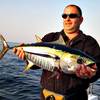So many times I hear about guys trolling lures, getting a hook up and then loosing the fish, mostly because they panic and then react incorrectly to deal with the situation.
The first rule is: do not panic, take it easy and stay calm.
Lets start at the beginning with your drag settings, personally I like to troll with my drags set as low as possible to allow the fish to run and swallow the lure properly, with Kona's and Feathers I would usually set my drag at 1/3 of the drag setting so on 24Kg tackle your strike would be set at 8Kg, your max drag should be around 12Kg on full, and so I would set my drags at around 2-3Kg when the spread is out, obviously for Rapala's and Halco's you will need to set this higher especially for the deeper runners which could need up to 6Kg. For Rapala's and Halco's you basically set the drag where the lure is not taking line.
You are trolling anywhere between 6 and 12 Knots depending on your lures and conditions, and you get a hook up and the reel starts to growl, or scream. What now?
- Remember the first rule, do not panic.
- Do not slow the boat down
- Do not turn the boat
- Do not touch the rod. And most of all DO NOT strike.
- Walk over to the reel making the noise and push the drag lever to full, or wind up the drag in the case of a start drag reel.
- If needed wind up line whilst the reel is still in the gunnel.
- Pick up the rod and start winding keeping pressure on the fish.
- When you feel you line has stretched enough and the fish is on solid and you have turned him, only then do you strike and then do it only once with a hard upwards movement and then hold the rod up high and start to reel down. In most cases you do not need to strike the fish will be on solid.
- Do not panic is line is still being taken.
- Now is the time for other crew to start clearing lines. Remember the man on the rod is the King.
- Now you have the rod in your hands and are ready to fight your fish, the line is tight and the fish hooked properly.
- Only then do you slow your boat down.
- When slowing the boat down this must be co-ordinated with the angler so that he is reeling and making sure there is no slack line.
- First slow down to about half the speed you were doing, and then with more communication slow down to both motors on idle but engaged, DO NOT stop the boat.
- By this time the other lines are cleared and all rods out the way.
Now the angler will fight the fish, and this must be done by pulling the rod up and reeling down, never for a moment must you give slack line when reeling down as this can result in either the line wrapping around the tip or the fish getting un-hooked, either way you will loose out.
Now you are starting to gain line and get the fish closer to the boat, if it is a larger fish and the angler is struggling to gain on the fish slow down to 1 motor engaged ONLY do this if absolutely necessary, NEVER disengage and fight the fish with the boat on drift, this gives far to much control to the fish, whereas with the boat moving you have control.
Now you get the fish close to the boat and it is of utmost importance that the boat is moving forward, in some cases you may have to even need to speed up to keep to the same speed as the fish, especially with bigger fish. Also an important note is that when the boat is moving during the fight and when the fish is close to the boat, your fish is less prone to being taken by a shark compared to when the boat is drifting.
Once you have the leader wound up a few times on the reel you can push the drag to sunset if it is a large fish giving you a hard time, but only if you have a thick leader, with Rapala's remember there is no leader so you cannot do this.
With a leader you can guide the fish next to the boat by hand, with Rapala's you must do this with the rod.
The boat is moving so the fish will not be able to go around the boat or the props, he will come alongside the boat and he will be much calmer than if the boat was still.
The Gaff man must hold the gaff or Boga Grip out of site until he is going to use it, if you hold it up it will scare the fish away, I like to hold it flat against the gunnels on the outside of the boat.
Then you gaff or grip your fish and pull him over board, in the case of Billfish wear gloves and use you hands to grab the Bill keeping the fishes head under water to keep him calm.
Some points to note, if the fish is small compared to the tackle I never even clear the lines or slow the boat down, just winch him to the boat grab the line and swing him over board.


